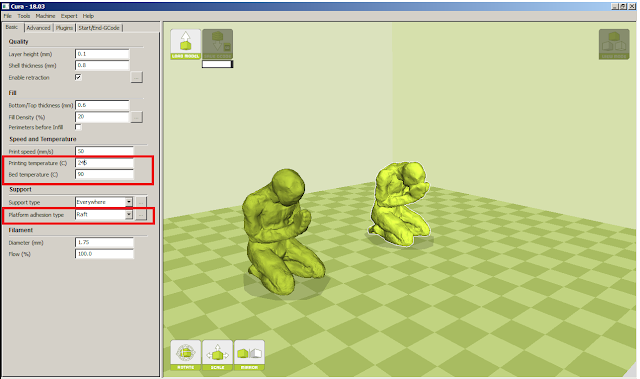Working
title
Revelation
Aim
of the project
The
original intention was to extend semester 1, fabrication and
construction's exploration into claritas and the human form.
Conceptually this work is exploring the foundation of the christian,
jewish and muslim faith, and its relevance.
Focus
on the titanic battle between good and evil for the souls of
humanity.
This
was explored through the creation of a set of figures are displayed
in the configuration of a game board. These figures were 3d printed
using glow in the dark filament.
The
intention was to create a set of figures of two types, one praying
man and one crying man. The intention with the human form
itself was to to reduce the form down to its basic components.
I am interested in the generalities not the particularities of the
individual to create that connection to the self.
This
work is intended to be installed in the white room at QCA on a small,
low plinth in the configuration of a game that is 'in play'.
The
key to this installation is not the figures themselves but the
installation.
consideration
for the installation and recording process are:
the
work is discussing the titanic battle for the souls of humanity
(within christian, islamic and judism context)
the
'game' is in play
the
board is not needed, as a discussion to our perception of this game,
we are unable to see the board
the
game is not chess or checkers, the rules of this game is unknown to
the viewer. We can project a set of rules such as the aformentioned
games but they may not apply.
in
recording a low camera angle which puts the viewer in the action as
opposed to being a spectator, in presentation of the installation it
is displayed from a low height, to put the installation into 'perspective'.
Theoretical
Framework
What
is the issue you are addressing in the work? What was the motivation
for doing the work?
The
work is an essoteric discussion on the foundation of judism,
islam and christianity, which keeping in mind that these faiths make
up over 50% of the worlds population (Adherents.com
) makes this a relevant contemporary issue. This discussion focuses on the titanic battle for our soul. This verison serves to discuss
from an analytical point of view, acting as a reminder that , as a
christian, we are involved in this game every day. That we cannot see
the board in play and our role with in it. We could be any of these
pieces.
Studio
Methodology
How
did you create the work and was process important in its creation and
why?
The
intention was two create two figures, this was achieved through the
physical creation, scanning and digital manipulation of the
praying man figure. The second figure , the crying man,
was created purely through the digital manipulation of the first.
The
figures were printed with ABS luminescent filament.
For
these prints a layer height of 0.2 was used. This greatly reduces print time (almost 50% less) and gave the forms a textured, almost
shimmery surface, which supports my conceptual focus of the soul and
claritas.
The
process of using 3d printing relates back to scripture , 'made in his
image' (Genisis 1:27), this is particularly important in regards to
the praying man. With the original form being Molded from air drying
clay which relates to Isaiah 64:8.
The
crying man was
digitally manipulated which relates back to the original sin,
knowledge.
Context
Compare
and contrast your work with two other practitioners in
the field who have similar aims to yours and support your conceptual
ideas.
In my research two artists were integral to the resolved work Amanda Parer and Alberto Giacometti.
Amanda
Parer challenges the notion of scale through her enchanting pieces
that explore the environment and the role of human beings in it.
And tries to
communicate this by using light and dark, humour and drama.
Her usage of glowing figures has been emulated within my own work but
myuse of scale explores our disconnection to the environment and the
connection between the viewer and artwork.
The
other key artistic influence was Alberto Giacometti's Walking man, the stylised male figure, with no individualised aspects, conveys the human condition. I chose retain some detail of the human
form but removed all identifyable facial features and minimised the
details of the hand. This process was a step in the direction to
abstract the human form to a minimum of information to convey a
'humaness'. This process of abstraction has been furthered for my
studio major.
Conclusion
How
is your work performing against your aims and theoretical framework?
Do
you have any evidence for this?
I feel that the use use of luminescent filament was successful in exploring the concept of claritas, tho i feel that for future projects the possiblility of increasing the intensity of the light will strengthen the aesthetic presence of the pieces. Conceptually the work is distanced and didactical in approach, which is a technique that I intend minimise in my practice now that it has been explored.
To extend on this project in the future my
intention is to upscale the idea of the gameboard with a shift of
conceptual focus to the participants place within this game. The
figures will be replaced with the participants and the gameboard will
become visible

















































:format(webp)/cdn2.vox-cdn.com/uploads/chorus_image/image/49191687/bunny1.0.jpg)